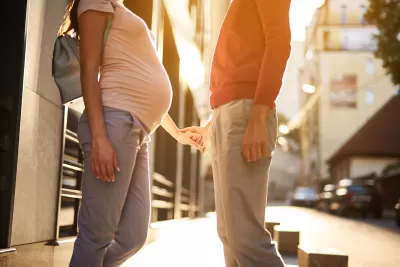More evidence of the public health benefits of walkable neighborhoods.

A new study published in the journal of Economics and Human Biology presents evidence of the immense health benefits of walkable communities for expectant mothers and their babies.
“Pregnant women that live in walkable communities—with more sidewalks, parks and walking paths—not only engage in more physical activity but are also more likely to experience favorable birth outcomes,” according to a press release from the University of New Hampshire announcing the study.
“They found that a 10-point increase in the walkability index—equivalent to transitioning from the "least walkable" to the "most walkable" category—is associated with a more than 70-minute increase in weekly exercise among pregnant women,” adds the press release. “This same change results in an 0.8 percentage point increase in the likelihood of a full-term birth, a 0.07-week extension in gestational age, a 27g increase in birth weight, and a 27% reduction in the likelihood of gestational diabetes and 16% reduction in hypertension.”
Researchers Karen Conway, professor of economics at UNH’s Peter T. Paul College of Business and Economics, and Andrea Menclova, associate professor of economics at the University of Canterbury used walkability measures created by the U.S. Environmental Protection Agency as well as detailed data on physical activity from the Behavioral Risk Factor Surveillance System and pregnancy outcomes from the National Vital Statistics Natality Detail Files to complete the study, according to the press release.
FULL STORY: Researchers Find Walkable Communities Are Healthier for Both Mom and Baby

Maui's Vacation Rental Debate Turns Ugly
Verbal attacks, misinformation campaigns and fistfights plague a high-stakes debate to convert thousands of vacation rentals into long-term housing.

Planetizen Federal Action Tracker
A weekly monitor of how Trump’s orders and actions are impacting planners and planning in America.

In Urban Planning, AI Prompting Could be the New Design Thinking
Creativity has long been key to great urban design. What if we see AI as our new creative partner?

How Trump's HUD Budget Proposal Would Harm Homelessness Response
Experts say the change to the HUD budget would make it more difficult to identify people who are homeless and connect them with services, and to prevent homelessness.

The Vast Potential of the Right-of-Way
One writer argues that the space between two building faces is the most important element of the built environment.

Florida Seniors Face Rising Homelessness Risk
High housing costs are pushing more seniors, many of them on a fixed income, into homelessness.
Urban Design for Planners 1: Software Tools
This six-course series explores essential urban design concepts using open source software and equips planners with the tools they need to participate fully in the urban design process.
Planning for Universal Design
Learn the tools for implementing Universal Design in planning regulations.
Gallatin County Department of Planning & Community Development
Heyer Gruel & Associates PA
JM Goldson LLC
City of Camden Redevelopment Agency
City of Astoria
Transportation Research & Education Center (TREC) at Portland State University
Jefferson Parish Government
Camden Redevelopment Agency
City of Claremont





























